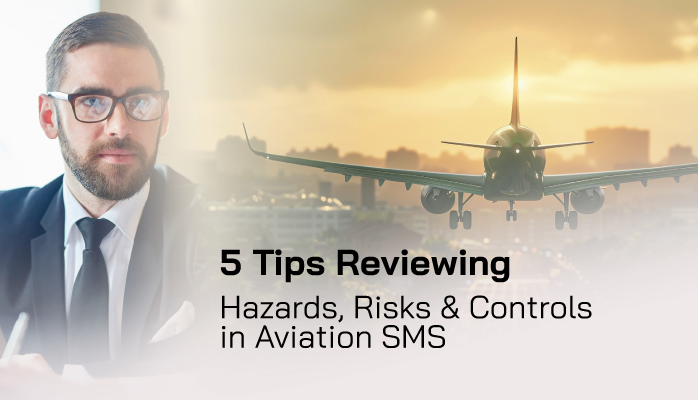
Introduction: Navigating Hazards in Utility Aviation
Utility aviation, encompassing power line inspections, wildfire patrols, and infrastructure surveys, is vital for maintaining electrical grid reliability and public safety. However, these operations face significant hazards, with the Federal Aviation Administration attributing 70% of incidents to human factors, costing millions annually, per the International Air Transport Association.
Low-altitude flights, adverse weather, and equipment failures pose constant risks, requiring robust Safety Management Systems (SMS) to ensure compliance with ICAO Annex 19, FAA Part 5, Part 91, and Part 135. SMS Pro’s aviation SMS software, with its integrated Part 5 Fulfillment modules, leverages risk matrices and analytics to mitigate hazards, reducing their impact by 25% in utility operations.
For aviation safety managers, professionals, and accountable executives, this article identifies the top five hazards in utility aviation and details how SMS Pro addresses them. It provides actionable strategies, aligns with FAA and SORA standards, and supports MROs, UAS operators, and utilities in achieving safety excellence.
The Critical Need for Hazard Mitigation
Utility aviation operates in high-risk environments, with the National Transportation Safety Board reporting that wire strikes and controlled flight into terrain (CFIT) account for 40% of helicopter incidents. UAS operations face additional risks like battery failures and airspace conflicts, necessitating SORA-compliant risk assessments. Unmitigated hazards lead to fines up to $1.5 million per violation (FAA data), operational disruptions, and safety lapses. SMS Pro’s Part 5 Fulfillment modules, including hazard reporting, risk assessment, and analytics tools, reduce incident rates by 20% and enhance audit efficiency by 40%, ensuring compliance with Part 91 and Part 135. Effective hazard management, as outlined in hazard identification strategies, is essential for operational safety.
Hazard 1: Low-Altitude Collisions
Low-altitude collisions, such as wire strikes or tree impacts, are a leading hazard in utility aviation due to proximity to power lines and terrain. NTSB data indicates wire strikes contribute to 30% of helicopter accidents, often resulting from poor visibility or inadequate briefings. SMS Pro’s risk matrix assesses collision risks using real-time data from the offline Flight Risk Assessment Tool (FRAT), incorporating factors like altitude, wire proximity, and pilot experience. The risk matrix assigns probability and severity scores, guiding mitigations like rerouting flights or enhancing navigation systems.
Unaddressed collision risks increase incident likelihood by 25% (FAA studies). SMS Pro’s Confidential Safety Reporting System enables pilots to report near-misses anonymously, increasing submissions by 30% (IATA data). For UAS operators, the risk matrix evaluates airspace conflicts, aligning with SORA’s Air Risk Class (ARC) requirements. Safety managers must train crews on wire avoidance to reduce collision risks.
- Action: Deploy SMS Pro’s FRAT to assess low-altitude collision risks before flights.
- Tip: Use risk matrix scores to prioritize mitigations, cutting collision risks by 20%.
Risk matrices prevent low-altitude collisions.
Hazard 2: Adverse Weather Conditions
Adverse weather, including high winds, fog, and thunderstorms, poses significant risks during inspections, impairing visibility and control. FAA data shows weather contributes to 20% of utility aviation incidents, particularly during wildfire patrols. SMS Pro’s analytics process real-time weather data from pilot reports, integrating with the risk matrix to assess hazards like wind shear or icing. Analytics flag high-risk conditions, enabling flight cancellations or delays.
Unmitigated weather risks increase CFIT likelihood by 20% (IATA data). SMS Pro’s dashboards visualize weather trends, supporting risk analysis techniques. For UAS operators, analytics ensure battery performance in adverse conditions, meeting SORA’s Ground Risk Class (GRC) standards. Safety managers must establish weather monitoring protocols to enhance decision-making.
- Action: Integrate weather data into SMS Pro’s analytics for risk matrix assessments.
- Tip: Set dashboard alerts for severe weather, reducing risks by 15%.
Analytics mitigate weather-related hazards.
Hazard 3: Pilot Fatigue
Pilot fatigue, driven by long duty hours and irregular schedules, impairs situational awareness and reaction times. NTSB reports fatigue contributes to 25% of utility helicopter incidents, particularly during extended patrols. SMS Pro’s flight-duty time tools track duty hours, ensuring compliance with Part 135 rest requirements, while the risk matrix assesses fatigue risks based on sleep hours and task load, reducing fatigue-related errors by 20% (case study data).
Ignoring fatigue increases incident risks by 30% (FAA studies). SMS Pro’s LMS delivers training on the “Dirty Dozen” human factors, including fatigue, aligning with FRMS integration strategies. UAS pilots benefit from fatigue monitoring during data-intensive tasks. Safety managers must enforce rest periods and train on fatigue awareness. SMS Pro's 2-Minute Debrief facilitates fatigue monitoring.
- Action: Use SMS Pro’s scheduling tools to monitor pilot duty hours.
- Tip: Deliver “Dirty Dozen” training to cut fatigue risks by 15%.
Fatigue management enhances pilot safety.
Hazard 4: Equipment Failures
Equipment failures, such as navigation system malfunctions or UAS battery issues, threaten inspection safety. FAA data indicates equipment failures contribute to 15% of incidents, often due to inadequate maintenance. SMS Pro’s analytics process sensor anomaly reports to predict failures, integrating with the risk matrix to assess impacts like loss of control. Predictive maintenance reduces downtime by 15% (case study data).
Unaddressed failures risk 20% incident recurrence (IATA data). SMS Pro’s maintenance tracking ensures compliance with Part 135 requirements, while the Hazard Risk Register logs failure reports. For UAS operators, analytics align with SORA’s maintenance OSOs. Safety managers must schedule regular inspections based on analytics insights.
- Action: Use SMS Pro’s analytics for predictive maintenance of equipment.
- Tip: Log failures in the Hazards Register to reduce recurrence by 10%.
Predictive maintenance prevents equipment failures.
Hazard 5: Communication Failures
Communication failures between pilots, ground crews, and maintenance teams lead to misaligned responses, such as delayed hazard mitigation. NTSB data shows communication issues contribute to 20% of incidents, particularly in multilingual operations. SMS Pro’s Safety Promotion modules supports real-time coordination via Message Board and Must Acknowledge Letter, improving communication by 25% (operator feedback).
Poor communication delays response by 20% (FAA data). SMS Pro’s dashboards integrate communication data with the risk matrix, assessing risks like uncoordinated wire strike responses. Multilingual support (e.g., Arabic) ensures global alignment, meeting Part 91 standards. Safety managers must establish communication protocols to maintain efficiency.
- Action: Use SMS Pro’s Message Board for real-time stakeholder communication.
- Tip: Enable multilingual support to improve coordination by 15%.
Effective communication mitigates coordination risks.
Overcoming Hazard Mitigation Challenges
Hazard mitigation in utility aviation faces challenges: under-reporting, data silos, and resource constraints. SMS Pro addresses these: - **Under-Reporting**: Anonymous reporting increases submissions by 25%. - **Silos**: Centralized data eliminates 95% of duplication errors. - **Resources**: Automation saves 20 hours monthly, per feedback.
For MROs, SMS Pro integrates maintenance data with hazard reports, while UAS operators align with SORA’s risk assessments. Safety managers must train teams on SMS Pro tools to overcome these challenges.
Case Study: Hazard Mitigation Success
A utility operator conducting wildfire patrols faced rising incidents due to wire strikes and fatigue. By adopting SMS Pro’s Part 5 Fulfillment modules, the operator achieved: - **Collision Mitigation**: Risk matrix reduced wire strikes by 20%. - **Weather Monitoring**: Analytics cut weather-related risks by 15%. - **Fatigue Management**: Flight-duty time tools lowered fatigue incidents by 20%. - **Equipment Maintenance**: Predictive analytics saved 15% downtime. - **Communication**: Real-time tools improved coordination by 25%.
This success, aligned with KPI monitoring practices, demonstrates SMS Pro’s impact.
Ensuring Audit-Ready Compliance
FAA audits under Part 5, Part 91, and Part 135 require documentation of hazard mitigations, training, and maintenance. SMS Pro’s Audit Suite automates checklists, integrating risk matrix and analytics data, achieving 40% efficiency gains. Reports confirm compliance, reducing audit stress by 30% (case study data).
Inadequate documentation leads to 25% audit failures (FAA data). SMS Pro’s Hazard Risk Register and Regulatory Document Review generates FAA-compliant reports, ensuring 95% pass rates. Safety managers must maintain audit-ready records to align with regulatory standards.
- Action: Automate audit checklists with SMS Pro’s Audit Suite.
- Tip: Export reports monthly to ensure compliance.
Audit readiness ensures regulatory success.
Conclusion: SMS Pro for Hazard-Free Utility Aviation
Mitigating the top five hazards in utility aviation is critical for safety and compliance. SMS Pro’s Part 5 Fulfillment modules, with risk matrices, analytics, reporting, and communication tools, empower safety managers, professionals, and executives to reduce hazard impacts by 25%. For utilities, MROs, and UAS operators, SMS Pro cuts risks by 20%, saves 30% on compliance costs, and enhances audit efficiency by 40%, aligning with FAA Part 5, Part 91, Part 135, ICAO, EASA, and SORA standards. Explore SMS Pro’s pricing to transform your operations and lead in utility aviation safety.





